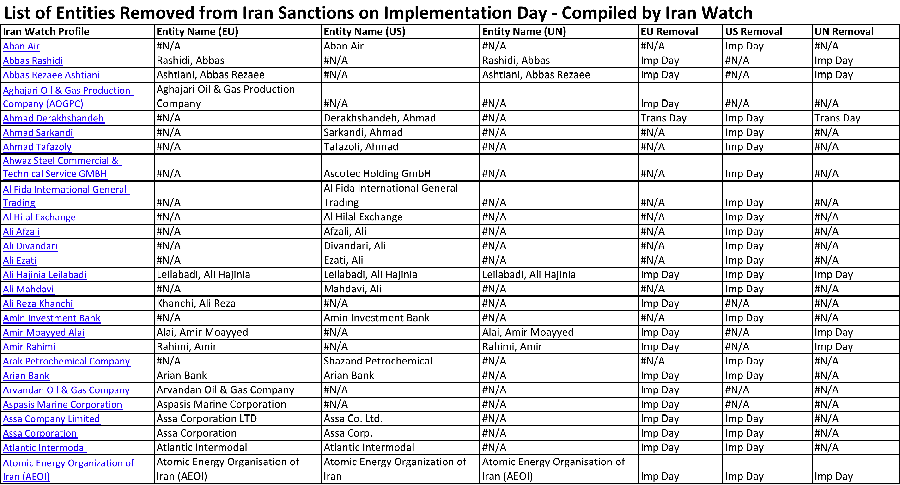Spreadsheet of Entities Removed from the  E.U., U.N., and U.S. Lists
E.U., U.N., and U.S. Lists
Iran and the P5+1 announced on January 16, 2016 that Iran had met its initial obligations under the terms of the nuclear agreement. “Implementation Day” brought a first round of sanctions relief for Iran, including the removal of some 600 individuals and firms from the European Union, United States, and United Nations blacklists.
These removals were included in three separate lists attached to the Joint Comprehensive Plan of Action and U.N. resolution 2231, sometimes with the same entity included under a different name across the various lists. In many cases, entities removed from the E.U. list on Implementation Day had never been designated by the United States, and vice versa. In a few instances, entities were removed from one list on Implementation Day but will remain on another blacklist until Transition Day (estimated to take place in October 2023).
To clarify the changes to these blacklists and support sanctions compliance, Iran Watch has created an Implementation Day spreadsheet that includes every entity that was removed from the E.U., U.S., and U.N. lists (with the exception of the individual vessels and aircraft). This spreadsheet will help support continued vigilance with regard to Iran, in particular toward Iranian entities that until this month had been under strict financial sanctions because of their support for proliferation. Compliance officers at companies preparing to resume dealings with Iran should continue to avoid many of these entities because of the support they have provided to Iran’s nuclear, missile, and military programs. And officials charged with enforcing the nuclear agreement should work to ensure that, for example, the companies previously targeted for facilitating illicit procurement have not resumed this activity now that they have been officially cleared.
The spreadsheet matches entity names from each of the lists into unified entries; shows when each entity was or will be removed from individual blacklists; and links to a profile on Iran Watch that describes an entity’s connection with proliferation. The spreadsheet also notes those entities that were removed from the U.S. Treasury Department’s Specially Designated Nationals (SDN) list on Implementation Day but were identified as “Government of Iran” or an “Iranian financial institution” and therefore remain off-limits for U.S. parties. These entities have been added to the oddly-named “Non-SDN List,” pursuant to Executive Order 13599.
In general, the timing of removals across the different blacklists was consistent. However, there were a few anomalies worth noting. For example, Bank Sepah, Bank Sepah International, and Ahmad Derakhshandeh (a former Bank Sepah chairman) were removed from the U.S. blacklist on Implementation Day but will remain on the E.U. and U.N. blacklists for now. Bank Sepah was moved to the Executive Order 13599 List, but not Bank Sepah International or Mr. Derakhshandeh. Bank Sepah International would seem to qualify for at least this lesser list, as it describes itself as “a wholly owned subsidiary of Bank Sepah.” Update: U.N. sanctions against Bank Sepah and Bank Sepah International were lifted on the heels of Implementation Day, following a delisting request. This change was confirmed on the U.N. website in February.
The Implementation Day spreadsheet is available for download as an Excel file below:


